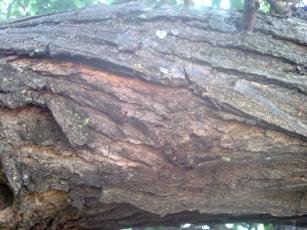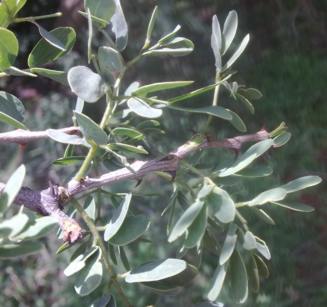Senegalia mellifera subsp. detinens
Senegalia mellifera (Vahl) Seigel & Ebinger subsp. detinens (Burch.) Kyal. & Boatwr.
Family: Fabaceae
Common names: black thorn (Eng.); swarthaak, blouhaak, hakiesdoring (Afr.); monga (Tswana); mongangatau (Northern Sotho); munembedzi (Tshivenda); monkana (Siswati)
SA Tree No: 176
Introduction
This is a thorny shrub or small tree with sweetly scented flowers and with hard, attractive wood.

Description
Description
This is a very thorny shrub to small tree with rounded or spreading flat crown which may reach down to ground level, occurring in bushveld and semi-desert areas, often on Kalahari sand and often growing in circular groups forming impenetrable thickets in overgrazed areas. The bark varies from light to dark grey and is longitudinally fissured; these fissures are generally darker. Thorns occur in pairs at nodes which are spaced at intervals of 5-15 mm, sometimes up to 30 mm. There are thus more thorns per unit length of branch than with other species. The thorns are hooked and blackish.

Leaves are twice compound, with 2-4 pairs of pinnae (primary divisions), leaflets 1-3 pairs per pinna, relatively large, 3,5-15 x 2-12 mm, petiolar gland present, glands present at base of at least upper pinna pair. There are 1-4 leaves per node. They are green initially, the same shade both above and below, but become glaucous when older. Main and lateral venation is visible on both surfaces. Leaflet margins are sparsely fringed with white hairs. The combined length of petiole (leaf stalk) plus rachis (the axis of a compound leaf) is up to 40 mm long. This stalk is sparsely pubescent, though sometimes glabrous on young plants, and is slender and light green. A petiole gland is usually present; the petiole is hairy.

Flowers usually appear in August or September before the tree comes into leaf and make an attractive show. A second flowering has been observed in March following heavy rains. The flowers are cream to white, but they take on a brownish hue when fading. They are sweetly scented. The pods develop rapidly after flowering has taken place. They are small, straw-coloured or pale brown, thin to almost papery, straight, smooth, dehiscent (opening spontaneously when ripe) and 25-80 x 13-25 mm (January-April).

Conservation Status
Status
Senegalia mellifera is not listed under the Tree Species Protected list in terms of National Forest ACT of 1998 (ACT 84 of 1998). In the Red Data List, this taxon is given the Least Concern status.
Distribution and habitat
Distribution description
From the Northern Cape in the south, to the Free State, Gauteng, North-West Province, Mpumalanga, the Limpopo Province, and northwards to Tanzania. In the Northern Cape Province it occurs mainly in the northwestern portion, notably in the Vryburg, Taung, Barkly West and Keimoes areas. In the Free State it grows in the western portion: Jacobsdal and Fauresmith areas. In Gauteng, Limpopo, Mpumalanga and North West Provinces: it is found over most of the bushveld areas, down to the Springbok Flats north of Pretoria.
In Namibia it is found in the Caprivi Strip, Kaokoveld, Otjiwarongo, Outjo, Okahandja and Gobabis Districts and further south. In Botswana it occurs in the eastern and southern regions.
It prefers deep sandy or gravelly soils and puts down a very deep tap-root. Found in arid savanna, dry woodland and bush. A drought-resistant species.
Derivation of name and historical aspects
History
This species was previously known as Acacia mellifera. The generic name ` Acacia ' comes from the Greek word ` akis ', meaning point or barb; mellifera means honey-bearing, referring to the sweet-scented flowers; detinens : to hold, referring to its vicious hooked thorns. The genus name Senegalia is a reference to the country further north in Africa, Senegal. There are two subspecies :
- Subsp. mellifera usually has 2 pinna pairs and hairless leaflets, whereas subsp. detinens has 3 pinna pairs and leaflets with a fringe of marginal hairs.
- Subsp. detinens : is the most widespread subspecies in southern Africa. Subsp. mellifera : occurs in the extreme northwest of Namibia and further north, with a reddish trunk and rather larger leaflets.
- Flowers on subsp. mellifera are usually closely packed along the dark, rigid branchlets, white, distinctly in spikes whereas in subsp. detinens they are apparently in balls (actually in very shortened spikes).
Senegalia mellifera is somewhat similar to S. nigrescens but lacks the prickly knobs on the trunk. It has smaller, paler and papery pods and much shorter inflorescences. A . nigrescens does not have white lenticel markings on the young branches.
Ecology
Ecology
Twigs and pods are very nutritious to livestock and game; in the wild it is browsed by animals such as black rhino, kudu, eland and giraffe. This species spreads rapidly, both from seed and vegetatively, to the extent that it can become a menace, forming impenetrable, tangled thickets.

Uses
Use
Twigs are chewed and used by humans as toothbrushes. The heartwood is termite-resistant and used as fencing posts. The pods, young twigs, leaves and flowers are all highly nutritious and are eagerly eaten by stock and game. The dark heartwood becomes almost black when oiled and highly polished. The wood is attractive, hard, and used as fuel. Bush encroachment by Acacia mellifera, which is due to inappropriate veld management practices (mainly overgrazing by domestic livestock), is a major problem in many parts of the Kalahari Plateau Bushveld.
Growing Senegalia mellifera subsp. detinens
Grow
Seed ripens quickly and can be ready for collection before the end of November. After heavy rainfall at this time of the year, seeds still attached to fallen pods may be found germinating in great profusion. Bring water to the boil, immerse seed attached to the pod, leave to soak for 24 hours and then sow, in the same condition. Seeds transplanted into packets progress slowly and are not likely to be more 200 mm high by the end of summer.
They should, however, be planted out during the next summer as the extensive root system may be impossible to straighten out if the plants are left too long in the packets. Growth after planting out is also slow. The young plants are reputed to be tender to frost but not enough experience has been gained to be able to report fully on this aspect. Some die-back has been noted on small unprotected plants following severe cold.
The species is extremely drought-resistant. It would seem to have a preference for deep sandy or gravelly soils and puts down a very deep tap-root. It is worth cultivating for its fine floral display. In areas where it occurs naturally it provides good shade for stock, but populations increase rapidly and are thus liable to make incursions on such grazing as is available.
References
- Carr, J.D. 1976. The South African acacias . Conservation Press,, Johannesburg.
- Coates Palgrave, M. 2002. Keith Coates Palgrave Trees of southern Africa, edn 3. Struik, Cape Town.
- Schmidt, E., Lötter, M. & McCleland, W. 2002. Trees and shrubs of Mpumalanga and Kruger National Park . Jacana, Johannesburg.
- Smith, G.F. & Van Wyk, A.E. 2001. Regions of floristic endemism in Southern Africa: A review with emphasis on succulents . CTP Book Printers, Cape Town.
- Van Wyk, Braam [A.E.] & Van Wyk, P. 1997. Field guide to trees of southern Africa . Struik, Cape Town.
- http://www.zimbabweflora.co.zw/speciesdata/species.php?species_id=126050
- Kyalangalilwa B, et al. 2013. Phylogenetic position and revised classification of acacia s.l.(Fabaceae Mimosoideae) in Africa, including new combinations of Vachellia and Senegalia. Botanical Journal of Linnean Society 172,500-523.
Credits
Frank Nonyane
Pretoria National Herbarium
January 2013
Plant Attributes:
Plant Type: Shrub, Tree
SA Distribution: Free State, Gauteng, Limpopo, North West, Northern Cape
Soil type: Sandy
Flowering season: Spring
PH:
Flower colour: Brown, White, Cream
Aspect: Full Sun
Gardening skill:
Special Features:
Horticultural zones








Rate this article
Article well written and informative
Rate this plant
Is this an interesting plant?
Login to add your Comment
Back to topNot registered yet? Click here to register.